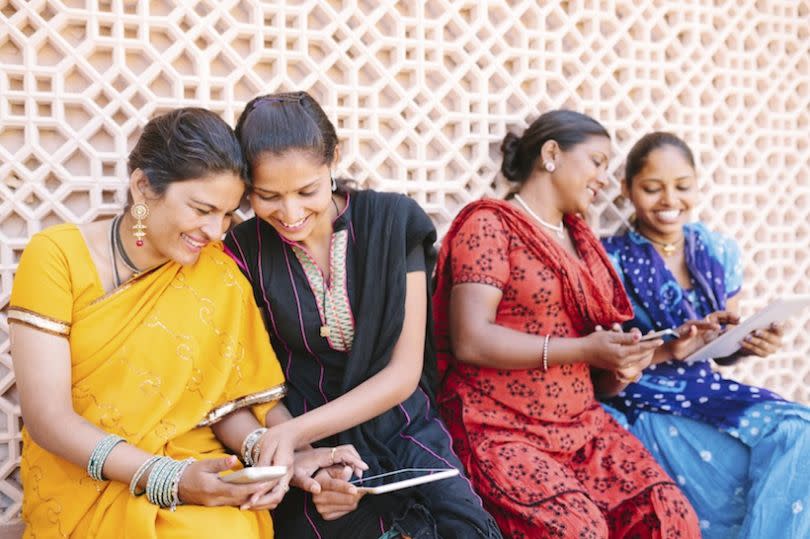A 12-year old girl from an Indian village couldn't attend any of her online classes today. Why do you think that is?

Only 15% of rural households have access to the internet in India. Many families can’t afford smartphones for each member. Even in families that can, patriarchal conditioning has made sure that male members get priority to use the devices, while women are expected to invest most of their time in chores.
No internet
The family phone was being used for her brother’s classes
She didn’t get any time from household chores
All of the above
A survey of over 3,000 children reveals how they spent time during the lockdown. How many girls reported spending most of their time on care/household work?

Yes, 71% girls reported spending time on care/household work during the lockdown, according to a survey by Centre for Budget and Policy Studies (CBPS). This heavily contrasts with only 38% boys spending any time on care work.
32%
71%
19%
84%
What percentage of children viewed/listened to educational broadcasts on TV or radio during the lockdown?

In a country as geographically and socially diverse in India, not everyone enjoys the same kind of access to resources like education and the internet. Measures were brought in to impart education via TV, radio, etc. However, only 11% children viewed/listened to educational broadcasts on TV or radio during the lockdown according to the Centre for Policy and Budget Studies.
Less than 15%
15%-30%
30%-50%
Over 50%
How many students (from Uttar Pradesh, Bihar, Assam, Telangana, Delhi) received support from the Education Departments during the lockdown?

Only 31% of our respondents as per the CBPS survey indicated that they received some support from the Education Department which was in the form of receiving any kind of support either in cash, kind or in any other form such as receiving alternative education, to avoid children dropping out of school. The reach and support of these provisions has mostly been limited and largely insignificant.
15%
31%
50%
87%
Do you think girl students liked their life more before the lockdown?

Students from the five states surveyed by CBPS certainly seem to think so. In fact, in Bihar, 89% of girls stated that their life was better before the lockdown! Most of the students surveyed expressed their inability to study at home and how much they missed social interactions. The isolation really took a toll on their mental health. For girls, this was made worse with the added pressure of household work.
Yes
No
The pandemic has raised several questions about students’ return to school. How many children in Assam are uncertain about going back to school?

Yes, well-over half the students in Assam are unsure about returning to school. Other states echo similar conditions. The CBPS survey found economic hardship to be a primary reason for this. Many economically-weaker families struggled to afford even basic needs like food during the pandemic. Thus, there are possibilities that they may not be able to pay for schooling and children might be forced to take up work to contribute to the family income or get married early.
41%
91%
63%
27%
How many children experienced food shortages in their homes?

63% of the students surveyed reported not having enough food at home. At 71%, Bihar reported the highest food shortage. Families resorted to cutting down on nutritious milk and vegetables, surviving only on cereals. They also borrowed money, sold their assets and in dire cases, went hungry. In addition to this, students also haven’t had access to mid-day meals. This has severe consequences for their health and nutrition, especially for girls, given the nutritional discrimination they face.
Less than 20%
20%-40%
40%-60%
Over 60%
How many adolescent girls in India are anemic?

54% i.e. over half the girls aged 10-19 in India are anemic (NFHS-4). Anemia weakens their immunity and ability to study, focus and engage in other activities. A useful preventive option is iron and folic acid supplements, which are given to students weekly in schools. With schools shut, their access to these has been restricted. None of the girls surveyed received any such supplements during the lockdown, further endangering their health.
Less than 10%
10%-30%
30%-50%
Over 50%
How can girl students be supported if school closures continue or have to be re-implemented?

These are just a few measures that can make it easier for girls to continue their education while the pandemic lasts. It is also key that schools build back better post the pandemic, keeping gender in mind so as to provide adequate educational and psychosocial support to girls. You can find out more about such solutions and recommendations here.
Develop diverse and low cost distance learning material —radio, TV, SMS, printed material — which reaches girls equitably.
Continue essential care services during school closures — such as sanitary pad provision and mid-day meals — to maintain good health and hygiene.
Ensure home visits and communication between teachers and students, to support learning and keep girls connected to the school.
All of the above
You got {number correct}/{number of questions} correct answers
Covid-19 has set back the strides girls' education made in India. Here's how you can learn more. Demand action by tweeting to policy makers by heading here.
You got {number correct}/{number of questions} correct answers
Covid-19 has set back the strides girls' education made in India. Here's how you can learn more. Demand action by tweeting to policy makers by heading here.
You got {number correct}/{number of questions} correct answers
Covid-19 has set back the strides girls' education made in India. Here's how you can learn more. Demand action by tweeting to policy makers by heading here.